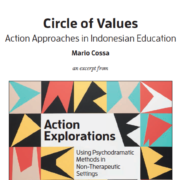Written by: Mario Cossa, RDT/MT, TEP, TSM Certified Trainer

During my time living in Bali, I have had the opportunity to connect with The Green School, an environmentally-conscious, alternative school for Primary- through High-School students that serves students from around the globe, as well as local children.
I have done a few parent workshops, provided staff training (especially prior to the school’s re-opening with a hybrid model), and offered support for a few students and families. As TSM’s youth specialist, I have brought the principles of our model to my work with adolescents and families.
Since March, 2020, when Green School went totally virtual to finish out the year (including a ZOOM Graduation for year 12 graduates), I have had many parents contact me about issues their children were having with panic attacks, anxiety, depression, and unsettled (if not unruly) behaviors.
There are several neurological considerations that make adolescence (currently defined as from the outset of puberty until about the mid-twenties) a highly volatile time in the best of circumstances.
The Amygdala, the part of the mid-brain that determines emotional significance, swells to three times its former size. This intensifies feeling states and helps the young person to move from the black-and-white, good/bad thinking of childhood and begin to distinguish between the shades of gray along the good/bad, pleasant/unpleasant, safe/unsafe continuum.
The Pre-Frontal Cortex, responsible for the executive function of the brain that allows control over actions, is still developing (at an enormously rapid rate, but requiring a lor of practice to fine tune.)
The more primitive parts of the sympathetic and parasympathetic nervous systems, responsible for “fight, flight, or freeze,” do not distinguish between the danger of contemporary life situations and attack of pre-historic humans by predators on the savannah; danger is danger.
Add to these conditions the tremendous changes that occurred during 2020 with a global pandemic, political and social unrest, and shifting climate. In working with these young people and their parents, my first task was to normalize what was happening. I would be more concerned by the young person who did NOT feel anxiety, panic, depressed, or unsettled.
I found that sharing with these young people strategies for releasing tension and anxiety and for re-setting the Ventral Vagus Nerve (or “Smart Vagus;” the part responsible for social connection), combined with validating their experience was generally an effective way to help them gain some stability in this unstable time. What follows are links to several You-Tube videos I thought were clearly presented: https://www.youtube.com/watch?v=L1HCG3BGK8I&t=23s and
https://www.youtube.com/watch?v=dkJDrfL90rU&t=247s
The good thing about these links is that once you watch them, You Tube starts suggesting others of a similar nature.
One final piece that is important for parents and youth workers to recognize, is that during times of disturbance for the young people with whom we live or work, our own un-resolved adolescent issues are triggered. It is important for us to do our own work so that we can remain in our “adult” roles to support these adolescents.
 Watch for future TSI e-blasts for information on a personal growth group I will be facilitating on Wednesdays via ZOOM, May 26 through June 16, at 2 different times to accommodate different time zones: 2-5PM Hong Kong Time, and 6-9PM New York Time.
Watch for future TSI e-blasts for information on a personal growth group I will be facilitating on Wednesdays via ZOOM, May 26 through June 16, at 2 different times to accommodate different time zones: 2-5PM Hong Kong Time, and 6-9PM New York Time.
Contact me at cossa@att.net for details.

